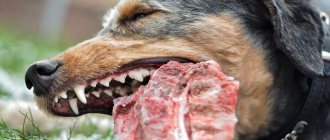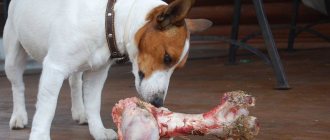The appearance of a four-legged friend in your home is a joyful event. Basically, dogs come to their owners' homes as puppies. Therefore, modest behavior is considered normal. For several days the puppy will hide and hide in corners, but the love, patience, and caring attitude of the owners will do their job, and very soon the baby will happily run around the house. However, if over time the situation does not improve, and the dog, even as an adult, is afraid of people, not only strangers, but sometimes even loved ones, the alarm should be sounded. It is likely that the animal is suffering from some kind of physical or mental injury. And every caring owner considers it his duty to understand the problem.
The dog is afraid of people, what should I do?
Dog-human interaction
It is not a dog's nature to be afraid of people. Thousands of years have passed since the domestication of the beast by man. Dogs are faithful companions in hunting, recreation, long trips and in life. Today there are special animals that help sick people, so-called guide dogs or animals that distract from stressful situations.
For a dog, interaction with a person is also of great importance. Firstly, an animal that has its patron in the form of a person is self-confident, not subject to stress and anxiety, and easily socializes among its relatives. In addition, close interaction with people provides the basis for the development of the animal’s mental abilities. The dog takes actions in order to express its emotions, desires and feelings to the person. For example, at the moment of a strong impulse of tenderness and love, he begins to lick the owner, when he wants to eat, takes the desired position, and when the phrase “let's go for a walk” he waits at the door. An animal that has a close connection with people is highly trainable and responds to a huge number of commands without any problems. And animals that get along with people live longer. This is shown by various sociological studies.
Dogs are faithful companions to humans
Who is allowed to be afraid?
In fact, there are situations that allow animals to experience fear and it will be considered normal. Let's consider several options for the development of events when fear is a natural reaction to what is happening.
If you have just taken a puppy into your home, and the dog is seeing you for the first time, then it is likely that during the first three to four days he will experience fear in your presence. This is expressed by uncertainty, a change of location. Early separation from the mother also leaves its mark. If you are going away for a while and you leave your dog with strangers or people who rarely appear in your home, the animal may also experience stress for several days.
The same goes for your move. If a dog finds itself in a new environment, and in addition to its owners, there are other people in the house, it may experience fear during the first few days. The animal is prone to fear if hospitalization and medical procedures are required. The animal will remember that there were strangers next to it, which caused a painful sensation. Therefore, during the rehabilitation period he will be afraid of strangers.
When first entering the house, the dog will experience fear for the first three to four days.
The dog often yawns when near its owner
Sometimes I see a dog yawning over and over again, which means he may be nervous. Some dogs may exhibit this behavior even if they are not tired. Just like people, dogs can experience nervous tics when they are around someone they are uncomfortable with. For example, a person plays with his hair or shakes his leg, or bites his nails when he is nervous.
During Filaret's funeral service, people looked into the sky and saw doves: video
Didn’t take rejection like a brick: little-known facts from the life of Igor Vernik
COVID vaccine effectiveness may be reduced by stress and depression
Root cause
However, if the above situations did not find a place in your life, and the dog still experiences such phobias, it is worth thinking about the root causes. If a dog is afraid of a person, and not only of strangers, but also of its own owner, it means that it has a very susceptible and, at the same time, traumatized psyche. All fears that arise in an animal when it sees a person are divided into two categories.
- These are the ones that have a reason.
- And the reason for which, unfortunately, is impossible to see.
Let's look at the first category. If fear has its basis, it means that the animal received negative emotions, was in a dangerous situation or experienced pain. Most often, fear is a consequence of life experiences. Thus, dogs that once happened to be caught by dog handlers, experienced rough treatment and bullying, are rarely inclined to communicate with humans. Those people who have a similar structure to the torturers will remind the animal of what they have experienced.
The cause of fear of people may be a traumatized psyche
Fears that have no reason are often recorded by veterinarians. For example, an animal becomes afraid when a baby cries. Or he begins to be afraid of any family member for no reason, while the person has never done anything bad to the animal. If you can determine the cause of the phobia, it will be much easier for you to fight it.
The dog needs to be helped to overcome uncertainty, but in no case should it be supported. Sometimes animals are insecure due to the fact that they are weak in front of their relatives. This feeling of weakness carries over into the home, where the animal feels vulnerable in the presence of people.
If a dog is afraid of other people: what to do?
If a dog is afraid of people, it is worth understanding the reasons. This can happen if:
- The dog was mistreated and often punished. In this case, the animal gets used to seeing a person as a threat and constantly expects punishment from him.
- The dog is not socialized, most of the time he is locked up, not seeing people. It is possible that in this case your pet is afraid of the unknown, which includes people unfamiliar to him.
- The dog has a weak nervous system. This quality is innate and to retrain a dog, to wean it from being afraid, it will take a lot of time, patience and care.
- Unexplained fears , the reasons for which were laid even before we adopted the pet. Here you should carefully observe whether the animal is afraid of all people or only men (women, children). Based on the results of observations, it is necessary to build behavior correction.
- Distrust of a person and lack of self-confidence. This happens more often if the dog was adopted from a shelter or picked up on the street, where it had to suffer all sorts of things from animal haters. Such fear can only be treated with love and a patient attitude.
Fear of people
What to do in such cases?
- First, understand exactly how fear manifests itself. If a dog runs away at the sight of a person, you should not chase it, shout, much less punish it for disobedience or, which is equivalent, calm it down with lamentations.
- It is better to give the dog the opportunity to run away, and then calmly, without shouting, call it and, after it stops, approach it yourself. Calmly pet your dog and put him on a leash, then continue your walk.
- If a dog barks until it becomes hoarse or lunges at a stranger , there is no need to grab it sharply, pull the leash, or even scream. This will scare the animal even more. To find out the reasons for aggression and correct behavior, it is better to enlist the help of an experienced dog handler.
- If the matter is limited to growling, then you can hold the dog by the leash or collar and give a simple command “Be silent!” or “Quiet!” Don't scold or praise the dog, just talk to him calmly.
All of the above recommendations are universal and are suitable for raising a dog of any breed. But still there are small nuances. You will learn about them further.
Host mistakes
If the dog is prone to experiencing fear, then your behavior can either eliminate this problem or, on the contrary, aggravate it. Many owners, unfortunately, out of ignorance, make a lot of mistakes that lead to not the best results.
The dog needs help to overcome fear
Let's look at the most common ones.
- Screaming is not the best way to achieve obedience from an animal. Most likely, you will scare the dog by letting him know that you are also afraid.
- Using physical force or harshness is the worst thing you can do in the fight for excellent behavior. The animal will experience pain and resentment from having received such a blow from its owner. And he will also perceive this as your fear and lack of knowledge of what to do next.
- Encouragement. By starting to calm the animal by stroking, caressing it or picking it up, you will provoke such behavior. The animal will understand that it was really frightened, and this is how it needs to behave in the future.
- Do not make sudden movements under any circumstances. It is possible that the animal was previously abused when it lived with a breeder or another family. And every sharp wave of the hand or sharp statement becomes a signal of danger for the dog; it expects physical action to follow.
- Reluctance to give the dog for training. If an animal is not only afraid of people, but also tries to attack them, then you should think about professional training, because perhaps the animal will cause serious harm to someone.
- Rewarding in the form of treats for being scared is not the best motivation. If a dog wants to get the coveted delicacy, it will deliberately feign fear and learn to skillfully manipulate you.
Video - The dog is afraid of people. What to do?
Passive reaction
The dog runs away from the person who scared it. The owner tries to call the animal, but these actions are unsuccessful. The owner begins to chase the animal and scolds it. Or, on the contrary, you calm your ward, pet him, and give him a treat. If you behave as described above, then you are encouraging a phobia.
What should you do in such a situation?
- Allow the dog to move to a distance that is safe in its opinion.
- If the dog runs too far, there is no need to call it, scold it, or call it using commands.
- As soon as the animal stops, turn around and calmly walk towards the pet. Maintain arm's length distance.
- Make sure the animal is happy to see you and not afraid.
- Walk around the back of the dog and stand behind it, while squeezing the sternum with your legs. Attach the leash. In this case, the animal must be stroked on the neck all the time, without making it clear that you agree with the behavior.
- Command “Nearby”, give a few more simple executable commands. The dog should see that you feel as calm as possible, while being friendly towards it.
Under no circumstances should you reward your dog for being scared.
Very soon the animal will forget that it was scared of someone, because your behavior does not remind it of this fact.
Important! Your task is to show your dog that you are always there for him, while the frightened object is not scary for you. The animal will change your confidence and begin to copy your behavior. Next time she will simply walk around the object, frightened, but will not run away.
The dog doesn't make eye contact
If a dog moves away from its owner when he tries to pet it, it means that it is uncomfortable. Sometimes a dog may deliberately ignore its owner. I always notice whether the dog looks into the owner's eyes or whether he walks away every time he tries to approach her.
Why critics are predicting failure of the new “Sex and the City”
Folk fun, not an Orthodox tradition. Why you shouldn't swim in an ice hole
The unknown love of John Lennon, which he tried to forget all his life
Aggressive reaction
It manifests itself in shouting at a four-legged friend, running, sudden movements of the leash and collar, and swearing. The animal looks at your behavior and understands that you also experienced fear, which prompted you to such an aggressive reaction. This behavior will become the basis for the dog to reason that people really need to be feared. What to do in this case?
To correct behavior, it is best to contact a trainer
If your dog has already attempted to bite someone, you need to contact a trainer who will train the animal. Unfortunately, an aggressive animal should not roam on its own. Your steps should look like this.
- You must control the situation.
- The tug on the leash should not be strong.
- Command “Quiet!” If your command does not help, start leading the dog around you.
- Hold his chest between your knees and begin stroking the animal's neck.
- Wait until the frightened object moves away.
- Then place the animal next to you.
- Give the command "Nearby".
- Pet the dog and say, “Okay, good job.” However, this is not praise, but just a statement that defending yourself is good, but there is no need to lash out.
Important ! In order for all the tips given above to work, it is necessary that your animal knows at least two commands “Ugh!” and “Quiet!”
Video - The dog is afraid of people. What to do? Part 2
Lack of socialization
Very often, owners become the reason for this behavior of the animal. And it's not a matter of beatings and hostile behavior. Many animals are kept locked up, but do not see strangers, their relatives.
It is necessary to start walking when the puppy reaches three months of age. It is from this moment that the dog begins to actively comprehend the world around him, understands that there are still a lot of people around who are not aggressive and live their own lives. If a dog is kept locked up and then accidentally ends up on the street, then it experiences fear from everything unknown, and even more so from strangers.
The dog must be introduced to people and other animals as early as possible.
The dog leaves the room the owner enters or tries to keep his distance
I notice that some dogs keep their distance. A dog that doesn't want to interact with its owner won't stick around when he comes indoors. Besides avoiding eye contact and being ignored, dogs can easily leave the room.
Persistent ringing in the ears may be a sign of vitamin B deficiency: study
10 celestial events to watch in 2021
A golden retriever has taken on the duties of a furry nanny for his owners' family.
When should you visit the vet?
Unfortunately, sometimes the reason for such animal behavior is not the lack of proper education from the owner. Weakness of the nervous system is a common reason why an animal cannot normally enjoy walks. Due to the fact that the nerve endings do not function properly, even adults behave differently, constantly on guard.
Such animals have a high risk of stroke and other diseases that lead to death. They may be frightened by rustling noises, a crying child, or sounds that are somewhat louder than normal. The main reasons that you should visit a veterinarian are involuntary urination during loud noises, fear and shaking if the owner raises his voice a little, and panicky fear of other people. The veterinarian must examine the animal and take tests if necessary. If it is determined that the dog has a weakness of the nervous system, and possibly other diseases, appropriate treatment will be prescribed.
Weakness of the nervous system is one of the reasons for a dog’s inadequate reaction to people.
If a dog generally feels bad, it considers itself vulnerable and snaps at absolutely all strangers from whom it can receive a threat. For example, animals that suffer:
- diseases of the gastrointestinal system;
- hearts;
- feels weak;
- elevated temperature;
- dizziness and pain;
- become an easy target, and realizing this, they try to protect themselves.
Therefore, before learning commands with animals and trying to socialize him in any way, be sure to make sure that nothing bothers the dog.
Video - How to overcome the fear of dogs
Causes of fear in dogs
There may be several reasons why a dog is afraid of people:
- Poor treatment of a dog from an early age can lead to the fact that he will not only avoid strangers, but in every possible way avoid contact with them. As a rule, this behavior is typical of those puppies that were taken from breeders, and not from experienced dog breeders. It is quite possible that physical force was used on the puppy. In addition, this reason cannot be denied if the pet was taken by an adult from a shelter.
- If a dog shys away from people on the street, then most likely it lacked socialization at an early age. By the age of 3 months, the baby learns about the world. If during this period the puppy did not communicate with people and did not gain experience, then it will be extremely difficult to teach the pet to behave calmly.
- Another common reason that dogs are afraid of strangers is that their nervous system is very weak. As a rule, a puppy is already born with this character trait. In the future, he may be haunted by various phobias that will appear like mushrooms after rain. That is why the owner will have to make a lot of effort to raise a calm and adequate dog.
Adaptation Tips
If you are sure that the dog is absolutely healthy, then you can begin to act. Here are some tips to help you stay on track and achieve results.
- Do not cancel your walks under any circumstances. Even if the animal is reluctant to go outside and constantly hides behind you, trying to protect itself from meeting other people, you should not follow the lead and stop walking.
- Start your walks in places that are not crowded with people. Gradually you begin to visit more and more crowded places.
- Keep your pet on a leash to reduce the likelihood of her running off in an unknown direction.
- If necessary, take valerian or other medications yourself that will restrain your nervous system. After all, explosions from the owner are the worst thing an animal can experience.
- Do not take food with you on your walk.
- If an animal is afraid of contact with its relatives, let it avoid them at first. The dog must observe from the side, thereby understanding that there is nothing dangerous. After a while, she herself will ask to join the company.
- If you are the owner of a dog that is currently in heat or gestation, then fear is a completely normal reaction for your health or future offspring, because during this period females are most vulnerable.
- If a lot of people, children, are really gathering around the animal, strangers are talking loudly, trying to flirt with the dog or make them angry, which makes the animal feel uncomfortable and afraid, then ask people to change the tactics of their behavior, or better yet, not to pay any attention to the animal until the moment until the latter adapts to the street.
- Do not deny your pet contact. If an animal requires affection or approval from you, encourage it in a friendly voice, stroke its head, scratch behind its ear.
- You may be giving your dog too little time, which is causing him to feel insecure. Having received the proper amount of attention from the owner, the animal will easily begin socialization in society.
Dog socialization
We are responsible for those we once tamed. If your animals experience problems, fear, unpleasant memories, then your task is to eradicate this. With the right approach, your confidence, and of course, excessive love, you will achieve results very soon.
The dog is afraid of strangers
Why might the practice of giving treats not work?!
When dogs show signs of aggression towards strangers (almost always aggression is caused by fear), very often trainers advise that strangers treat the dogs with treats during this behavior. Yes, this training method is based on forming positive associations with strangers, but it can be doomed to failure when working with fearful dogs.
Firstly, if a treat is used as a bait in order to reduce the distance between the dog and the person (which, in essence, is a kind of bribery), then this leads the dog into a state of internal conflict. Dogs want to eat a tasty treat, but at the same time they are very afraid to come closer to a stranger or little-known person. Conflict.
Let's say that the dog will take the offered treats and even approach the person, but this can happen: he suddenly realizes that he is too close to the stranger, not in his comfort zone, and the person will no longer have goodies to somehow smooth out the close contact .
Aggressive actions (growling, barking, lunging and imitation biting) are warning signals to ensure that the person giving the treats maintains a comfortable distance for the dog. When a stranger is too close to a fearful dog, it is more likely to resort to behavior that makes it feel safe. Thus, instead of creating positive associations when meeting strangers, we do the exact opposite, and also provide the dog with the opportunity to “practice” aggression to a greater extent, reinforcing this behavior.
A dog can understand it this way: if growling, barking, chattering teeth is acceptable and even treats you with a treat, then why not continue to behave this way towards other strangers.
Secondly, we have formed a positive association in the dog: a stranger appears - great, I run to him for a treat. Everything seems to be fine, but there is a serious catch.
When a dog approaches a stranger in anticipation of getting something tasty, then, of course, it looks friendly and welcoming. A man meets a “friendly” dog, but instead of giving it a treat, he begins to pet and cuddle it. For a fearful dog (and for any dog, in principle), such an unceremonious invasion of personal space is unacceptable. She, of course, responds to such behavior on the part of a person with aggressive attacks. And the negative association towards strangers only gets worse.
Thirdly, very often people with the best intentions towards shy dogs do not understand that after treating the dog with something tasty, they should not come close to it and try to pet it or, moreover, hug it. A dog learns quite quickly: if it receives a treat from a person, it will cuddle, it will fall into a trap. In the future, such a dog will react aggressively to the offer of a tasty treat as a world treat - bark or growl.
So, what should you do if your dog is afraid of strangers?! Take a HUGE step back. When we are just starting to work on developing a dog’s calm and confident behavior when faced with a frightening irritant (a person, a car, another dog), then the obligatory condition is to limit the contact between the dog and the irritant as much as possible.
Instead of asking people to feed your dog, start working at a distance from strangers that is comfortable for the animal. And you should give your dog a treat. The behavior of your dog should determine the choice of a comfortable and safe distance: for one dog, it is enough to take a few steps away from it, and for another, the person will need to move away several tens or even hundreds of meters.
Loving strangers is not your primary goal. It is much more important that the dog understands that the presence, even remote, of strangers does not pose a danger to it. She is next to you, a person she trusts, and also treats her with delicious things.
The next steps largely depend on the condition of your dog, the environment, the behavior of strangers (and we have plenty of freaks) and other circumstances. Don't act hastily. You can try the parallel movement method, which will allow your dog to gradually reduce the comfortable distance between him and the people who frighten him. It would be wise for you to find a qualified dog behavior trainer to help you and your dog cope with this problem.
And, of course, do not listen to the advice of people or dog handlers who believe that a dog should be punished for showing aggression. Displays of aggression are an outward symptom of a deeper psychological problem in the dog. Receiving a tasty treat from a stranger is, alas, not a panacea for “cure” this problem. And, if you decide to “fight” this behavior by using punishment (scolding or, moreover, pulling the leash, hitting), then the problem will only get worse.
Translated by Anton Volkov, trainer, dog behavior specialist











